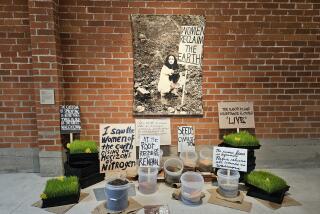The Fine Art of Advertising : Two entrepreneurs are racking up on a Euro-trend--free postcards. Yes, <i> free.</i>
- Share via
It’s not some retro “Candid Camera” stunt. No test of honesty or integrity.
Though you might have wondered.
Possibly you’ve already seen them around town, at your favorite coffeehouse along the La Brea corridor, at that low-lit yet lively West Hollywood bistro. A hanging rack loaded up with postcards of edgy collages, striking still lifes of faded sunflowers, moody photo tableaux. Something on the order of the art-card variety, available at many a high-toned boutique, starting at about a buck-25 a pop.
But why does this sign exclaim “FREE”?
That’s what stops a woman taking a mimosa break during a recent Saturday brunch at Cha Cha Cha in east Hollywood. Perplexed, she stares at the sign attached to a rack. Free? Her eyes ask her equally confounded friend. She puts one card in her bag. Looks around. Then, after a beat, takes a handful more.
“That’s common,” says Annett Sell. “People always think there’s a hitch.”
“And there is!” teases Jan-Peter Flack, then shakes his head. “The hitch is that there isn’t one.”
Both Sell and Flack, who are from Germany, were surprised that this phenomenon hadn’t already swept the States. Free postcards emblazoned with big-name ads are available at cafes and restaurants all over Italy, Switzerland, England, Austria and the Netherlands, Flack explains.
“But the advertising is very blatant,” he says. “You might get one nice postcard and the rest are crappy--with no aesthetic consideration.”
What Sell and Flack have set out to do with their cottage-industry enterprise, Pik:Nik Free Postcards, is multifold. Playing up the fine art aspects, they’ve set out to provide a different mode of advertising.
Their customers are independent artists who have tired of the usual attention-getting routes (from gallery crawls to portfolio peddling), or companies shooting to attract a more sophisticated and style-conscious audience through a more personalized campaign strategy.
“So you are much more direct, and far less expensive,” Flack says.
But, he emphasizes, “To justify something like this, the artistic aspect of the cards dominates the racks--so that whoever has the rack doesn’t feel exploited.”
“And,” Sell adds, “neither do the customers.”
Sell and Flack, who make their living in the entertainment industry as a set designer and art director, respectively, are sensitive to those aesthetic considerations. They were both surprised as well that the European version of the cards were so popular, despite some mediocre designs or blatant product hawking.
“Cafes and restaurants are one of the last intimate places where you’re not exploited by advertising,” Flack says. So in this venture, the partners want to make sure that the image is always the central focus, “where advertising and fine art are blurred. We want you to be lured into the beauty of the image. You have to look hard for the message.”
Out of their pooled creative impulses and resources, Pik:Nik was born. The name, Sell admits, grew out of their personal proclivities toward nostalgia.
“ Picnic is sort of a retro word and we are big fans of ‘40s, ‘50s and ‘60s design,” says Flack, who reports that their icon, a bikini-clad ‘50s babe, still lacks a name.
“And, the Pik ,” Sell adds, “plays on picking up the cards.”
Six months ago, the partners were hard pressed to persuade business owners or potential advertisers to pick up anything. Most wouldn’t buy into the concept until they’d seen some results. Recruiting a cadre of artist friends, they printed up the first batch of cards (10,000 of each design).
They had a time keeping the racks full.
“The cards are so popular,” Sell says, “now they want to meet us.”
And Pik:Nik has grown from 12 racks to about 70. The phone, she attests with a bewildered smile, doesn’t stop ringing: Artists responding to an early “Artists Wanted” card, restaurateurs wanting to find out where and how soon they can get their own racks installed.
Flack says at this point he is most interested in looking into such concerns as museums, book publishing, theaters, fine-dining establishments, as well as the film and fashion industry.
“It would be an excellent vehicle for the entertainment industry, to reissue classic jazz album covers, or a reprint of a ‘50s cult classic film poster with a very small tag line--so no one feels offended.”
And for independent artists?
With a rack that changes every month like a mini-gallery, the partners, looking at about 20,000 cards per image and growing, hope they can provide the sort of promotion and exposure benefits a rarefied gallery atmosphere never could.
And, they are happy to report, one photographer has already sold a print featured in a recent card series as result of the underground exposure.
But for now, the focus is to keep up with the demand.
“We never want to compromise the art,” Flack says. “There’s a lot out there that’s pathetic. We are in the visual arts, that’s how we make a living, and we vow to keep the integrity.”
In other words, they hope you collect ‘em all.
More to Read
Sign up for The Wild
We’ll help you find the best places to hike, bike and run, as well as the perfect silent spots for meditation and yoga.
You may occasionally receive promotional content from the Los Angeles Times.






